In the crowded landscape of generational labels, one group often gets overlooked: Generation Jones. Sandwiched between the Baby Boomers and Generation X, Generation Jones encompasses those born between 1954 and 1965. Sociologist Jonathan Pontell coined the term, aiming to capture the unique cultural and economic experiences of this cohort. His idea was to bridge the gap between these two familiar generations. But who exactly are the Jonesers, and what makes them so distinct? Let’s dive into the origins, cultural markers, and lasting impact of this fascinating generation.
The Overlooked Generation Between Boomers and GenX
Origins of Generation Jones
In an age where generational labels shape our understanding of cultural and social dynamics, Generation Jones—those born between 1954 and 1965—stands out as a pivotal but often misunderstood cohort. Skeptics may argue that Generation Jones lacks legitimacy compared to other generational monikers like Baby Boomers or Millennials. This critique, however, fails to recognize the distinct historical and cultural experiences that define this group.
The term “Generation Jones” was coined by cultural commentator Jonathan Pontell in the early 2000s. Pontell, through his work and research, identified a significant yet overlooked group wedged between the Baby Boomers and Generation X. He described them as the “Jonesers”—a generation characterized by their unique societal position and cultural experiences. Pontell’s definition emphasizes that this cohort experienced the tail end of the post-WWII economic boom but faced a world increasingly defined by economic stagnation and shifting social norms.
What Does Generation Jones Refer To?
The term Generation Jones might sound mysterious at first. “Jones” refers to the slang expression “keeping up with the Joneses,” which reflects the cohort’s characteristic consumerism and often unmet expectations. Unlike the Baby Boomers who basked in post-World War II prosperity, and GenerationX who came of age in a time of lucrative uncertainty and technological change, Generation Jones gets a blend of both worlds. The formative years of this neglected generation were a period marked by social disorder, the Civil Rights Movement, the Vietnam War, and significant economic shifts.
Unlike their Baby Boomer predecessors who witnessed the peak of post-war prosperity, Jonesers were often confronted with the disillusionment of the 1970s and early 1980s. They were adolescents and young adults during the era of Watergate, the energy crisis, and a shifting global landscape. This context imbued them with a distinct sense of economic anxiety and a more pragmatic worldview.
Scholars and sociologists have recognized the generational identity of Generation Jones. In his book, Generation Jones: The Forgotten Generation, Jonathan Pontell elaborates on how this cohort’s formative years shaped their collective attitudes and experiences. Pontell’s research is supported by academic studies, such as those by sociologist Neil Howe, who, while not exclusively focused on Generation Jones, acknowledges the cohort’s unique position between the Boomers and Gen X.
Refuting the “Nonexistent” Demographic Myth
Critics who argue that Generation Jones is a “nonexistent” demographic often base their claims on the notion that generational labels should reflect clear, sweeping social changes. However, this perspective overlooks the nuanced reality of generational experiences. Demographics are not always neatly delineated; they encompass a range of experiences and challenges that do not always fit into simplistic narratives.
For instance, the claim that Generation Jones is not a valid demographic fails to address the considerable body of research indicating that distinct sociological patterns can be observed in this group. As noted by historian and demographic expert Dr. William Strauss, generational labels serve as useful tools for understanding shared experiences and challenges, even if those experiences span a more fluid and less immediately apparent divide.
Additionally, the criticism often ignores the fact that Generation Jones has been acknowledged by various cultural and economic studies. The cohort’s distinct characteristics—ranging from their economic struggles to their cultural touchstones.
How Gen Jones Differs From Baby Boomers
While Baby Boomers are known for their idealism and rebellion, Generation Jones leans more towards pragmatism and realism. Boomers grew up during the prosperous 1950s and 60s, a time of economic boom and social upheaval. They were the flower children, the civil rights activists, and the anti-war protesters. In contrast, Generation Jones came of age in the 1970s and early 1980s, a period marked by economic downturns and political disillusionment.
Early boomers joined the workforce during the economic expansion that followed World War II, enabling them with a decade to create a more prosperous career for themselves before being faced with another downturn. While the Jonesers had the same societal experiences during their childhood, their careers didn’t take off until the stagflation that came later.
Remember the oil crisis of the 1970s? Gas lines stretched for miles, and Americans faced double-digit inflation. For Generation Jones, these formative years fostered a sense of economic insecurity and a more cautious outlook on life. While Boomers were idealists, Jonesers were realists, shaped by the sobering events of their youth.
Significant Events That Shaped Generation Jones
Born between 1954 and 1965, Generation Jones occupies a unique and often underappreciated space in the annals of American history. This cohort, bridging the gap between the Baby Boomers and Generation X, came of age during a time of profound change—socially, politically, and economically. While their older siblings rode the wave of post-war optimism, Jonesers were shaped by a series of tumultuous events that left an indelible mark on their collective psyche.
1. The Vietnam War and Its Aftermath
By the time many Jonesers were old enough to understand the world around them, the Vietnam War was already a painful reality. Unlike Baby Boomers, who were directly involved in the anti-war protests of the 1960s, Jonesers were more likely to witness the aftermath—the disillusionment, the scars of returning soldiers, and the national debate over the war’s morality. As historian James T. Patterson notes, the Vietnam War contributed to a pervasive sense of skepticism toward government institutions that would characterize much of Generation Jones’s worldview .
2. The Watergate Scandal
The Watergate scandal in the early 1970s was a formative experience for Generation Jones. As they approached adolescence and young adulthood, Jonesers saw firsthand the fragility of American political institutions. The scandal, culminating in President Richard Nixon’s resignation in 1974, bred a deep-seated cynicism and a distrust of authority. Political analysts, such as Garry Wills, have argued that Watergate was a critical turning point that shattered the post-war consensus and instilled a lasting sense of disillusionment in this generation .
3. The Oil Crisis of the 1970s
The 1970s were also marked by economic turmoil, most notably the oil crises of 1973 and 1979. As young adults entering the workforce or planning for their futures, Jonesers were confronted with stagflation—an economic condition characterized by high inflation, stagnant demand, and unemployment. The sudden and dramatic rise in oil prices not only disrupted daily life but also signaled the end of the post-war economic boom that their older siblings had enjoyed. Economist Paul Krugman points to this period as a pivotal moment that shaped the economic realities and anxieties of Generation Jones .
4. The Rise of Reaganomics
By the time Jonesers were fully entrenched in adulthood, the economic policies of Ronald Reagan were beginning to take shape. Reaganomics, with its emphasis on supply-side economics, deregulation, trickle down economics and tax cuts for the wealthy, promised to restore American prosperity but also deepened economic divides. Generation Jones, often saddled with the economic uncertainties of the previous decade, found themselves navigating a new landscape of corporate restructuring and shifting labor markets. Social commentator Barbara Ehrenreich has noted how these economic policies exacerbated the challenges faced by this generation, contributing to a sense of unfulfilled promise that many Jonesers still grapple with today .
5. Cultural Shifts and Technological Advancements
On a cultural level, Generation Jones was shaped by the seismic shifts of the late 20th century. They were the first to experience the rise of personal computing, the dawn of cable television, and the explosion of popular culture as a global force. Unlike Baby Boomers, who were rooted in the counterculture movements of the 1960s, or Gen Xers, who embraced the alternative movements of the 1990s, Jonesers often found themselves straddling these cultural divides. As author Tom Wolfe observed, the cultural environment of the late 1970s and 1980s was one of both unprecedented freedom and unsettling uncertainty—a duality that would define Generation Jones.
Generation Jones Technology
We lived through some of the coolest cultural and technological shifts ever. Sure, we saw our fair share of turmoil, but on the flip side, we got to ride the wave of some seriously awesome changes. Let’s dive into the pop culture and tech that shaped us.
Groovin’ To The Popular Music of Gen Jones
Music was a refuge for Generation Jones, offering a soundtrack to their tumultuous times. The 1970s and early 1980s saw a diverse range of genres dominate the airwaves. Rock and roll reigned supreme with legends like David Bowie and The Rolling Stones. Disco also had its moment in the sun, with Donna Summer and the Bee Gees getting everyone on the dance floor.
Punk rock emerged as a rebellious counterpoint to the mainstream, with bands like The Ramones and Blondie leading the charge. By the early 1980s, the advent of MTV revolutionized the music industry, giving rise to music videos and transforming artists like Madonna and Michael Jackson into global superstars.
This generation was bestowed a variety of distinguished artists that are still adored today. More of these musicians include Led Zeppelin, Elton John, Fleetwood Mac, Bob Marley, Dolly Parton, and Grateful Dead.
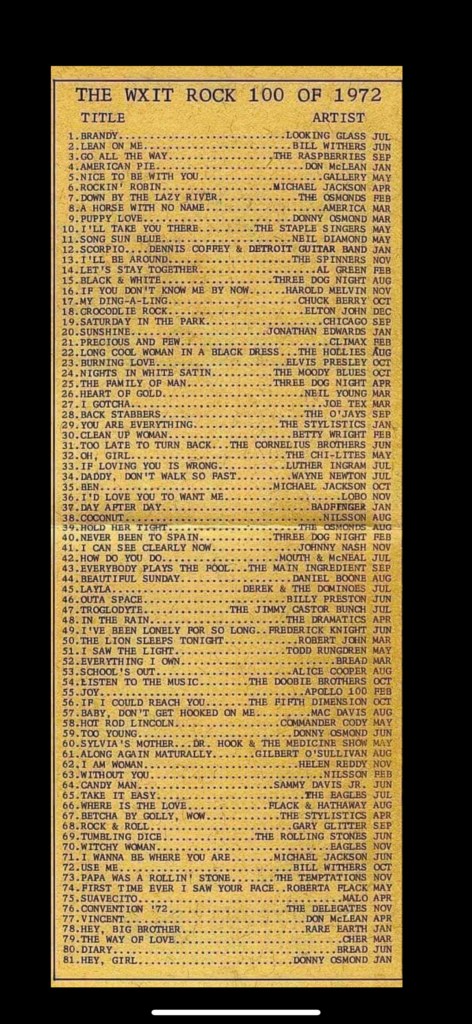
Popular Entertainment (TV, Movies, Books) of Generation Jones
Television, movies, and books provided a shared cultural experience for Generation Jones. Iconic TV shows like “The Brady Bunch,” “Happy Days,” and “MASH” became staples of family viewing. “Saturday Night Live” debuted in 1975, offering a satirical take on current events and launching the careers of countless comedians.
In cinema, the late 1970s and early 1980s were a golden age. Blockbusters like “Star Wars” (1977), “Jaws” (1975), and “Rocky” (1976) captivated audiences. “Saturday Night Fever” (1977) brought disco fever to the big screen, while “The Godfather” (1972) and its sequel (1974) set new standards for storytelling.
Books also left a significant mark. Stephen King’s early works like “Carrie” (1974) and “The Shining” (1977) thrilled readers, while “Roots” by Alex Haley (1976) and “The Exorcist” by William Peter Blatty (1971) became cultural phenomena.
Well-Known People/Celebrities/Musicians/Athletes Who Are Generation Jones
Generation Jones boasts an impressive roster of celebrities who have left an indelible mark on popular culture. In Hollywood, actors like Denzel Washington, Robin Williams, Meryl Streep, and Bruce Willis became household names. Tom Hanks, born in 1956, captured hearts with his versatility, from comedic roles in “Big” (1988) to dramatic performances in “Forrest Gump” (1994).
Music icons like Bruce Springsteen, Madonna, and Prince defined the sound of a generation. Springsteen’s anthems of working-class life resonated deeply, while Madonna’s boundary-pushing style and Prince’s genre-defying music set new standards for pop stardom.
On the sports front, athletes like Michael Jordan, Magic Johnson, and Martina Navratilova dominated their fields. Jordan’s gravity-defying dunks and clutch performances with the Chicago Bulls cemented his status as a basketball legend. Magic Johnson’s rivalry with Larry Bird electrified the NBA, while Navratilova’s dominance on the tennis court inspired countless young athletes.
Notable Generation Jonesers
- Barack Obama (born 1961): The 44th President of the United States, whose message of hope and change resonated across the nation.
- Oprah Winfrey (born 1954): Media mogul and philanthropist, whose influence extends far beyond her iconic talk show.
- Bill Gates (born 1955): Co-founder of Microsoft, who played a pivotal role in the personal computing revolution.
- George Clooney (born 1961): Actor, director, and activist known for his charismatic performances and humanitarian efforts.
- Ellen DeGeneres (born 1958): Comedian and TV host who broke barriers with her openly gay persona.
- Michael Jackson (born 1958): The King of Pop, whose groundbreaking music and performances left an indelible mark on the entertainment industry.
- Madonna (born 1958): The Queen of Pop, whose ever-evolving style and boundary-pushing music defined an era.
- Prince (born 1958): A musical genius whose innovative approach to music and performance continues to inspire artists today.
- Tom Hanks (born 1956): An actor whose versatility and relatability have made him one of Hollywood’s most beloved stars.
- Kamala Harris (born 1964): Vice President of the United States of America.
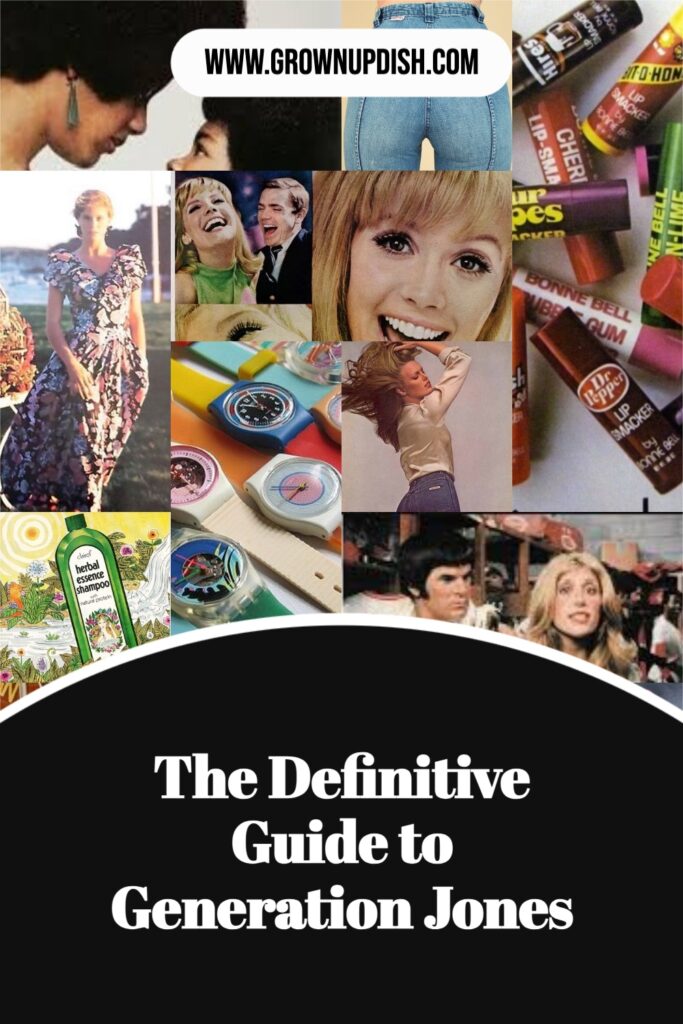
Style and Fashion of Generation Jones
Generation Jones occupies a unique space in fashion history. This cohort, often overshadowed by the Baby Boomers and Gen Xers, came of age during a time of significant social and cultural shifts. Their fashion choices reflect a blend of rebellion, practicality, and a quest for identity amid rapidly changing norms.
By the late 1970s and early 1980s, the fashion of Generation Jones started to reflect their growing responsibilities as they entered the workforce. The power suit became a symbol of this era, especially for women. Influenced by the feminist movement, women of this generation adopted sharp, tailored suits with padded shoulders, signaling their intent to succeed in a male-dominated corporate world. For men, suits remained a staple, but the traditional styles were often mixed with more daring choices like wider lapels, brighter colors, and bold patterns, reflecting a blend of professionalism and individuality.
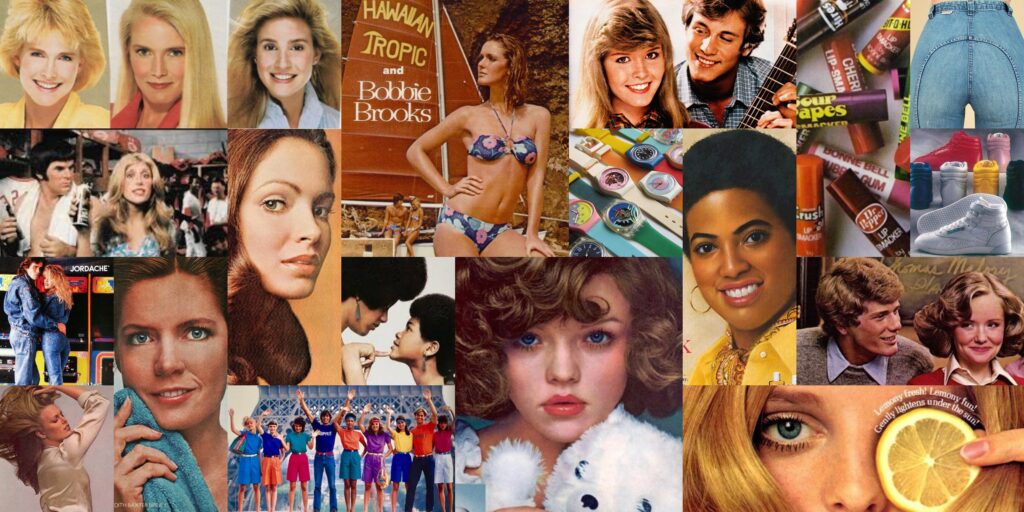
In their youth, members of Generation Jones were influenced by the countercultural movements of the late 1960s and early 1970s. The “hippie” aesthetic—marked by bell-bottom jeans, tie-dye shirts, and fringe—was initially appealing, symbolizing a desire to break away from the conservative values of their parents. As the 1970s progressed, however, this generation embraced a more streamlined and minimalist approach, reflecting the rise of disco and the beginning of punk.
Casual wear also evolved for Generation Jones during the 1980s. Denim was ubiquitous, transitioning from a symbol of rebellion to an everyday staple. The rise of designer jeans marked this shift, with brands like Calvin Klein and Jordache becoming status symbols. Athletic wear also made its way into mainstream fashion, driven by the fitness craze of the time. Tracksuits, sneakers, and sports-inspired accessories became popular, blending comfort with style.
As Generation Jones matured, their fashion sense evolved into one characterized by quality and timelessness. They became proponents of investment pieces—classic items that could endure changing trends. The emphasis shifted from making a statement to achieving a polished, put-together look that spoke to their established roles in society.
Groovy Memories – Gen Jones Popular Hair and Beauty Products
Whether you’re a late Baby Boomer, an early Gen X’er or part of Generation Jones (1954 – 1965) — If you grew up in the 1970’s you might have grey hair and wrinkles today but you surely remember these makeup and skincare products.
First up, Noxzema Skin Cream. This iconic cream was a skincare staple, loved for its deep-cleansing and moisturizing properties. Whether it was for acne or just that refreshing tingle, Noxzema had us covered! We used to slather it on our sunburned skin (because we never wore sunscreen!)
Pond’s Cold Cream was the go-to for makeup removal and moisturizing. It was the secret behind many a fresh-faced beauty, ensuring skin stayed soft and supple after all that pancake foundation, and Great Lash mascara
And don’t forget Oil of Olay? This luxurious moisturizer became a key part of many women’s daily routines, promising youthful, radiant skin. It was like a magic potion in a bottle!
Speaking of eyes, Maybelline Great Lash Mascara, with its iconic pink and green packaging, has been making lashes pop since 1971. It’s still a beauty bag essential today – talk about staying power!
For a scent as sweet as the ’70s themselves, Love’s Baby Soft Perfume was our choice – never mind the problematic advertising. With its powdery, sweet fragrance, it was sold on a weird premise of being innocent yet very sexy.
Hawaiian Tropic Suntan Oil promised that deep, golden tan we all craved, despite having virtually no SPF! It was the ultimate beach companion – when we weren’t using a homemade mixure of baby oil and iodine.
For a dazzling smile, Ultra Brite Toothpaste was the ticket. Its promise of a brighter smile made it a bathroom staple – because who didn’t want teeth as bright as the sun?
Revlon’s Charlie Perfume hit the scene in 1973, celebrating independent women everywhere. With its bold scent, it was more than just perfume; it was an attitude!”
Avon Skin So Soft started as a bath oil but quickly became famous for its versatility, including as a mosquito repellent. Talk about multipurpose magic!
CoverGirl’s Medicated Makeup was marketed as a lifesaver for teenagers battling acne. It combined coverage with acne-fighting ingredients, making it the ultimate double duty beauty product.
Speaking of acne, Ten-O-Six Lotion was our go-to astringent for combating oily skin and acne. What the heck was in that stuff?
FDS Feminine Deodorant Spray hit the shelves in the early ’70s, marketed as a personal hygiene product for women. It promised to “keep things fresh down there”, because confidence is everything!
And for our lips, we were all rocking Bonne Bell Lip Smackers. Coming in a rainbow of flavors, including the iconic Dr. Pepper, they were often worn on a string around the neck – because why not?”
Buckle up for a fun, hair-raising trip down memory lane! First up, ‘Gee, Your Hair Smells Terrific’ Shampoo. The name says it all! Launched in the early ’70s, it was famous for its long-lasting floral fragrance that could make heads turn from miles away. Literally, people could smell you coming!
Then we had all of the “herbal products” Clairol & Wella’s Herbal Essence Shampoo. With a scent that was supposed to made you feel like you were showering in a botanical garden, it became a staple in bathrooms everywhere. Peace, love, and lather!
Breck Shampoo was all about glamour. Their ‘Breck Girls’ advertising campaign featured models and actresses with impossibly shiny hair, setting the beauty bar high. Seriously, their hair could probably blind you with its shine!
“For those of us who wanted to go blonde, Sun In and Lemon Go Lightly was our weapon of choice. Unfortunatly it’s basically straight peroxide and it turned my hair bright orange. Ah, the sweet smell of disappointment and chemical reactions!”
Short & Sassy Shampoo and Conditioner catered specifically to short hair, featuring Olympic figure skater Dorothy Hamill. It promised to keep short styles looking fresh and vibrant. Because who doesn’t want to look like they just won a gold medal?
Now, let’s talk about the products that kept black hair looking fabulous! Afro Sheen was the go-to for that perfect, voluminous afro. It made sure your fro was on point, making it bouncier than a disco dance floor!
Murray’s Pomade, with its classic orange tin, was the secret sauce for slick, defined styles. This stuff was stronger than super glue! Once it was in, your hair wasn’t going anywhere. Windstorm? Bring it on!
And who could forget Dark & Lovely? This brand was a lifesaver for those looking to relax and straighten their hair without the drama. It was all about smooth, shiny, and simply stunning locks.
These products weren’t just about hair; they were part of the cultural tapestry of Generation Jones. Each one had its own unique flair and unforgettable charm. Which one was your go-to?”
And Let’s Not Forget the Gen Jones Guys
First up, Mennen Skin Bracer! Not just any aftershave—this was the post-shave punch in the face you never knew you needed! One splash, and whoosh, you’d be wide awake and feeling fresher than a morning jog in polyester pants.
Next, we have Barbasol Shaving Cream. Iconic, striped, and thicker than your uncle’s moustache. This stuff was smoother than a Barry White albu
And for that signature suave look, Brylcreem was the go-to. “A little dab’ll do ya,” they said, and boy, did it do wonders! Just a smidgen, and you were ready to hit the disco dance floor—without a hair out of place.
For those who wanted to give their locks some extra shine, Vitalis Hair Tonic was the magic potion. It gave you that perfect, Saturday Night Fever glistening look.
Now, if you wanted to turn heads Hai Karate was your secret weapon. With its spicy scent and promises of irresistible allure, it came with “instructions” to handle all the attention. Karate chop! And, Aqua Velva—because sometimes, you need an aftershave that’s as cool as ice! Brrrr!
And finally, the captain of them all—Old Spice! With a scent as classic as the sailboats on the bottle, Old Spice was the staple that took men from rugged to refined in a single splash.
How Many Of These Nostalgic Products Do You Remember?
Toys like Star Wars action figures, the Rubik’s Cube, and Stretch Armstrong became must-haves for kids. The Pet Rock craze of 1975 epitomized the quirky fads of the era. Fashion trends included bell-bottom jeans, platform shoes, tie-dye shirts, and leisure suits, all of which made bold statements about individuality and style.
The 1970s saw a wave of innovation and cultural shifts reflected in the products that defined Generation Jones. The Sony Walkman revolutionized how people listened to music, making it possible to take your favorite tunes anywhere. Polaroid cameras captured memories instantly, a novelty at the time.
Generation Jones Quiz
Now that you’ve learned about Generation Jones, take this quiz.
PIN IT!
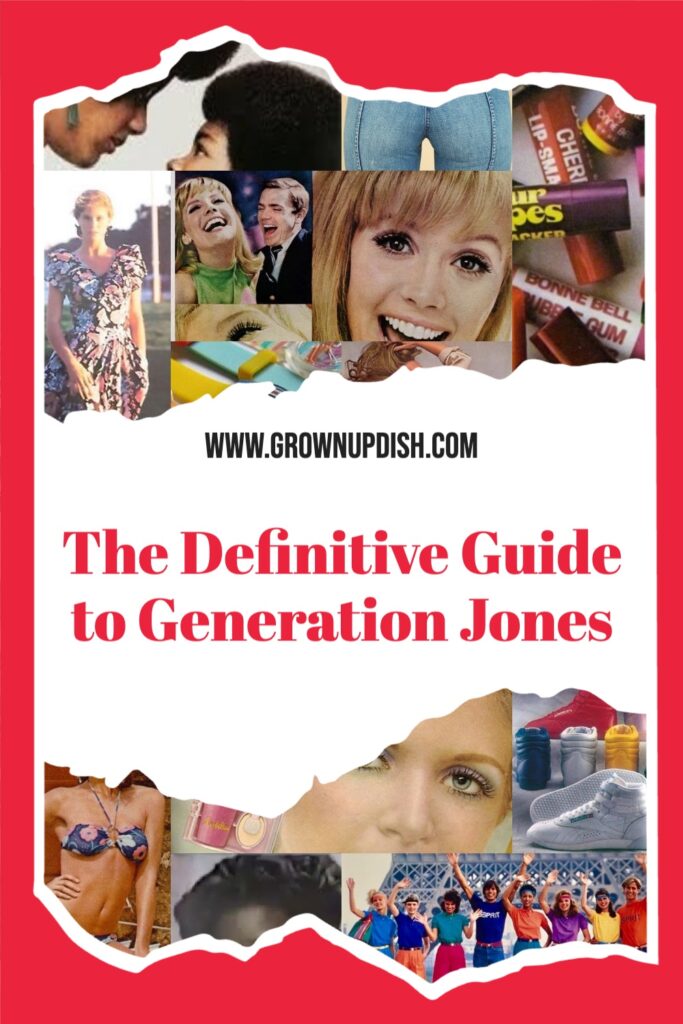
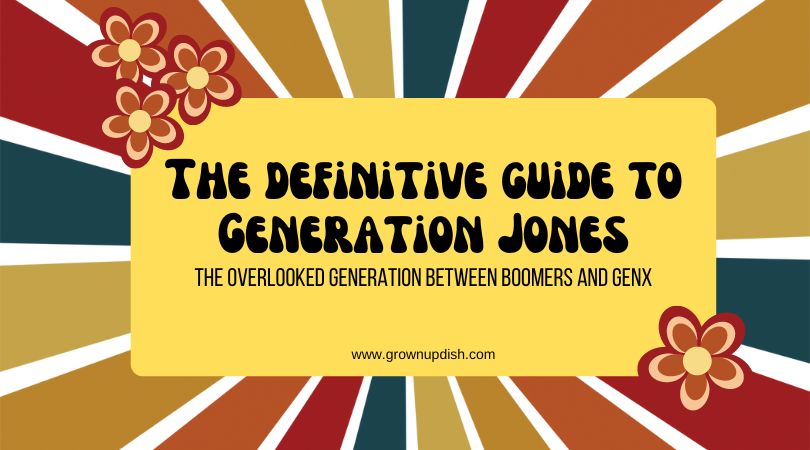
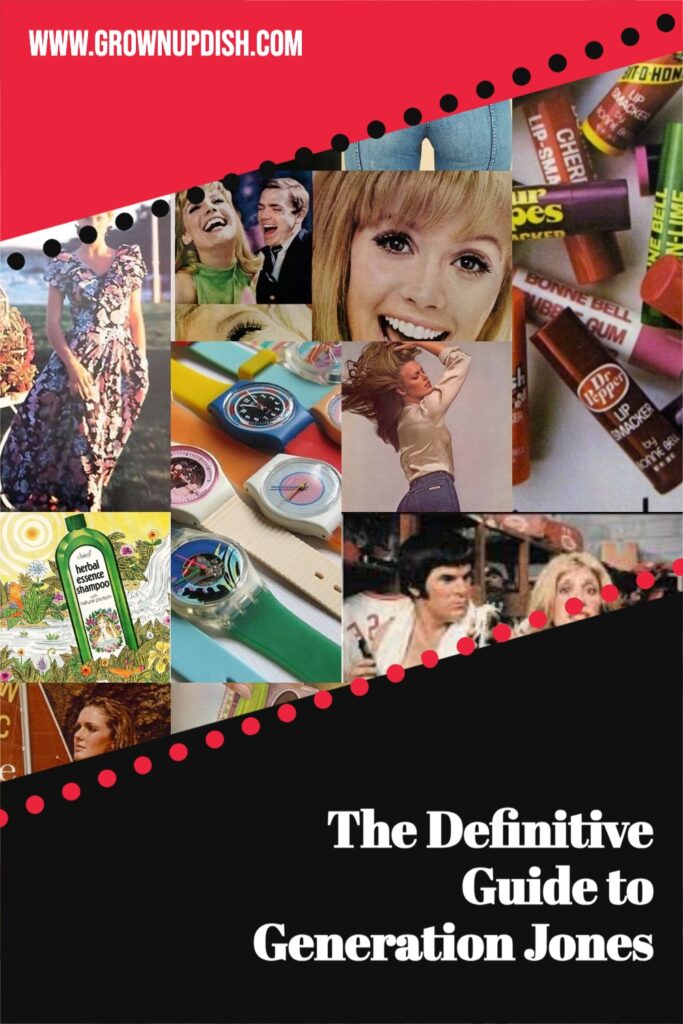
What a great article, nice trip down memory lane! Looking forward to part 2 of a couple of videos. Well done! 👍👍❤️
Some great info here; thank you for all the hard work that went into this. The main connotations of the term Generation Jones are that of an anonymous generation, and the slang term “jonesin'”. Jonesers made this slang popular as teens in the 1970s, but more importantly, the concept of jonesin’/craving fits this generation of huge expectations left unfulfilled. The ‘Keeping Up With the Jonesers’ connotation is one of several additional minor connotations of the term Generation Jones. You can find a list of those connotations on the About page of this new-ish site: https://GenJones.net/ This site is worth checking out generally, as it is filled with interesting info about Gen Jones, including over 100 prominent thought leaders talking about their agreement and identification with Gen Jones. Between that site and the Guide here, you can learn a great deal about our heretofore lost generation. Not so lost these days, though (e.g in just the last few weeks, there have been articles about Gen Jones in USA Today, Newsweek and The New York Times). Thanks again for this great Guide to Generation Jones.